Rayne Faingolts
This is my mother Rayne Faingolts. This picture was taken in Ukmerge in the 1930s.
My mother was born in 1883 in Ukmerge. She was given the rare Jewish name Rayne. I don't know exactly what kind of education she got. I think it was elementary. But still she was literate. She knew how to read and write in Russian, Polish, Lithuanian and Yiddish, and rudimentary mathematics. She helped me with that when I was in school. Her mother tongue was Yiddish, which was common for most of the Jewish population of Lithuania. Before getting married, my mother helped Grandmother Toybe about the house. My parents got married in 1907.
My mother did all the household chores with the exception of laundry. My mother was a wonderful cook. She made delicious dishes from inexpensive products. Potato and herring was the most common food for poor Jews in Lithuania. There was a shop not far from us where only herring was sold. Usually there was fresh herring, and herring which had been salted the previous year, which was twice as cheap. My mother bought the cheaper herring and we ate it everyday. Even now I consider herring and potatoes to be the tastiest food in the world. Sometimes we had soup. In winter time we had it with grain, and in summer with vegetables.
In summer it was easier for us as lemonade was in demand and my father received a certain percentage of the sales and made pretty good money. My mother had been saving all week long to lay the Sabbath table: we had gefilte fish on Saturdays no matter what. There was a lot of fish in Ukmerge and it was cheap. I still cook fish the way my mother taught me. At that time usually pike was stuffed. The fish was disemboweled, and cut into large pieces. Then, fillet was removed from the back. Fish meat was minced. Then croutons, onion, salt and a little black pepper were added in the mince. Then it was added to the remaining pieces of fish, from which fillet was taken. Vegetables were put in the pot: onion rings, carrots, then fish and then vegetables again. My mother didn't use beet. All that was sprinkled with salt and put in the oven for a couple of hours before the fish bones turned soft. Tsimes was a frequent dish on Saturdays. My mother cooked it the following way: she boiled fat beef, put there a lot of peeled and sliced carrots. That mixture was boiled, and then kneydlakh were added. Those are small dumplings made of flour, chicken broth or goose fat, egg, onion and salt. When there was no meat, my mother cooked carrot tsimes without it, and it was still very delicious.

















